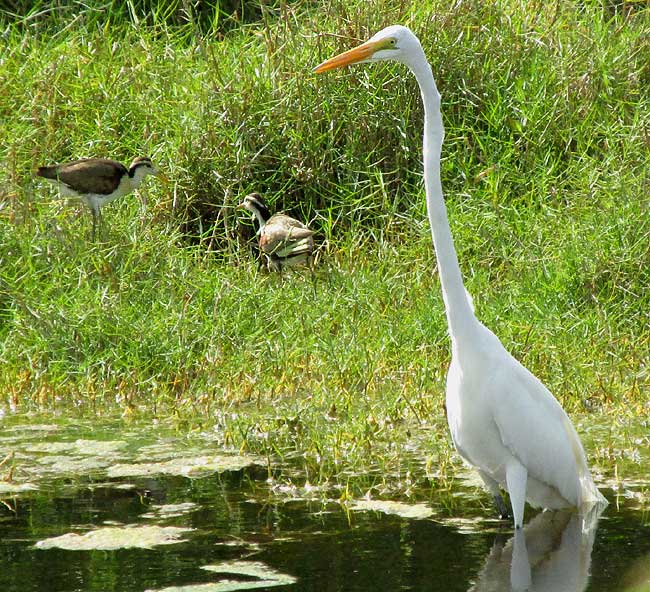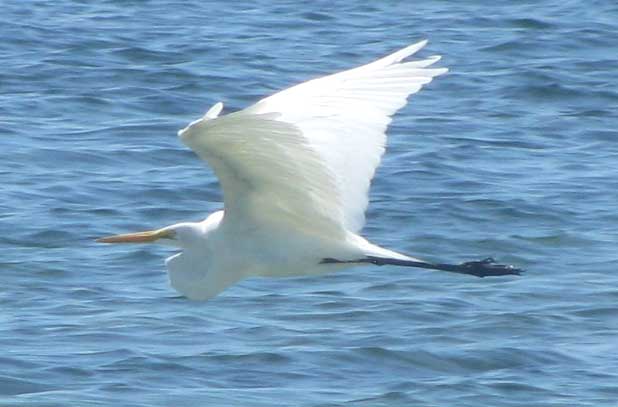Excerpts from Jim Conrad's
Naturalist Newsletter

from the February 1, 2015 Newsletter issued from Río Lagartos, on the Yucatan Peninsula's northern coast (~N21.60°, ~W88.16°), Yucatán state, MÉXICO
GREAT EGRET
One of the most commonly seen yet always spectacular birds in our coastal wetlands is the one shown above, in a roadside pond just south of Río Lagartos. That's the Great Egret, also known as the Common Egret, Great White Egret, and other names. It's ARDEA ALBA, and one reason for its many names is that it occurs throughout most of the world, except in the biggest deserts and the coldest regions. Another reason is that over the years experts couldn't agree on how to classify it. My dogeared 1966 field guide places them in the genus Camerodius; the 1995 guide to Mexican birds by Howell puts them in Egretta, and; most updated web pages now say they belong to Ardea. Gene sequencing has taught us that the Great Egret is actually closer related to pelicans than other birds known as egrets assigned to the genus Egretta.
In the picture, the smaller birds in the background are juvenile Northern Jacanas. The most riveting feature of the picture, however, is the big, white bird's incredibly long, slender neck. It's hard to believe that such a neck could have enough muscles to keep the head from flopping about, much less assume graceful poses and stab the head toward fish.
Flamingos fly with their necks stretched out before them, their whole bodies bobbing up and down with their wing beats. In contrast, Great Egrets fly with their necks retracted, their necks doubled back into a snug S. Maybe flamingos can get away with stretching out their necks because their necks, noted for being so long and slender, nevertheless are proportionally shorter and thicker than the Great Egret's.
Several herons and egrets in this area are white: the Snowy Egret, Cattle Egret, immature Little Blue Heron, the white phase of the Reddish Egret, and the white morph of the Great Blue Heron. Because of the Great Egret's size, it can be confused with none of these, except for the uncommonly seen white morph of the Great Blue Heron, which has yellow legs, not dark like the Great Egret. Great Blue Herons when disturbed tend to issue loud, complaining croaks, but Great Egrets are quieter, simply flying away gracefully when bothered.
Great Egrets are class acts wherever they are, and whatever they're doing.
from the August 7, 2011 Newsletter issued from Mayan Beach Garden Inn 20 kms north of Mahahual; Caribbean coastal beach and mangroves, ~N18.89°, ~W87.64°, Quintana Roo state, MÉXICO
AN EGRET FLYING BY
Not far down the beach from the night-heron a large, white wading bird stalked prey in shallows about fifty feet into the water. He was more nervous than the night-heron so he flew up before providing a good look. However, as the snowy bird passed by he offered a pretty sight against the blue ocean, as shown below.

With that yellowish beak he's not a white immature Great Blue or Little Blue Heron. He lacks the Snowy Egret's yellow feet, and his neck is too slender and his bill too big to be a Cattle Egret, so he's the Great Egret, in old books called the Common Egret, ARDEA ALBA.
Great Egrets also are nesting permanent residents in coastal Yucatán, so neither is this bird currently engaged in long-distance migration -- despite this being the first of this species seen since I got here three months ago.
In fact, the recent appearance of hoards of Purple Martins, the night-heron and this Great Egret all signal a whole new chapter to this year's birding here on the southeastern Yucatán coast. Though even still there aren't many birds out there, species diversity along our part of the beach has practically doubled within the last couple of weeks.